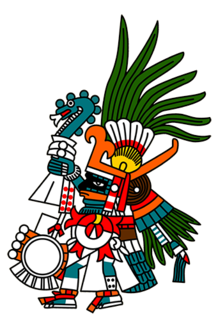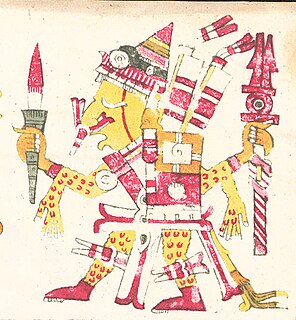
In Aztec mythology, Xolotl was a god associated with both lightning and death. He was also associated with the sunset and would guard the Sun as it traveled through the underworld every night. Dogs were associated with Xolotl. This deity and a dog were believed to lead the soul on its journey to the underworld. He was commonly depicted as a monstrous dog. Xolotl was the god of fire and lightning. He was also god of twins, monsters, misfortune, sickness, and deformities. Xolotl is the canine brother and twin of Quetzalcoatl, the pair being sons of the virgin Coatlicue. He is the dark personification of Venus, the evening star, and was associated with heavenly fire.

In the Aztec religion, Huitzilopochtli is a deity of war, sun, human sacrifice, and the patron of the city of Tenochtitlan. He was also the national god of the Mexicas, also known as Aztecs, of Tenochtitlan. Many in the pantheon of deities of the Aztecs were inclined to have a fondness for a particular aspect of warfare. However, Huitzilopochtli was known as the primary god of war in ancient Mexico. Since he was the patron god of the Mexica, he was credited with both the victories and defeats that the Mexica people had on the battlefield. The people had to make sacrifices to him to protect the Aztec from infinite night. He wielded Xiuhcoatl as a weapon, associating him with fire.

HuehueteotlWAY-way-TAY-oh-təl; Nahuatl pronunciation: [weːweˈteoːt͡ɬ] is an aged Mesoamerican deity figuring in the pantheons of pre-Columbian cultures, particularly in Aztec mythology and others of the Central Mexico region. The spellings Huehuetéotl and Ueueteotl are also used. Although known mostly in the cultures of that region, images and iconography depicting Huehueteotl have been found at other archaeological sites across Mesoamerica, such as in the Gulf region, western Mexico, Protoclassic-era sites in the Guatemalan highlands such as Kaminaljuyú and Late-Postclassic sites on the northern Yucatán Peninsula. The name Huehueteotl stems from Nahuatl huēhueh[ˈweːweʔ] ("old") and teōtl[ˈteoːt͡ɬ] ("god"). It seems to connect the Old God to certain Mayan deities called Mam ("Grandfather").

In Aztec mythology, Xiuhtecuhtli[ʃiʍˈtekʷt͡ɬi], was the god of fire, day and heat. He was the lord of volcanoes, the personification of life after death, warmth in cold (fire), light in darkness and food during famine. He was also named Cuezaltzin[kʷeˈsaɬt͡sin] ("flame") and Ixcozauhqui[iʃkoˈsaʍki], and is sometimes considered to be the same as Huehueteotl, although Xiuhtecuhtli is usually shown as a young deity. His wife was Chalchiuhtlicue. Xiuhtecuhtli is sometimes considered to be a manifestation of Ometecuhtli, the Lord of Duality, and according to the Florentine Codex Xiuhtecuhtli was considered to be the father of the Gods, who dwelled in the turquoise enclosure in the center of earth. Xiuhtecuhtli-Huehueteotl was one of the oldest and most revered of the indigenous pantheon. The cult of the God of Fire, of the Year, and of Turquoise perhaps began as far back as the middle Preclassic period. Turquoise was the symbolic equivalent of fire for Aztec priests. A small fire was permanently kept alive at the sacred center of every Aztec home in honor of Xiuhtecuhtli.

In Aztec mythology and religion, Xipe Totec or Xipetotec was a life-death-rebirth deity, god of agriculture, vegetation, the east, spring, goldsmiths, silversmiths, liberation and the seasons. Xipe Totec was also known by various other names, including Tlatlauhca, Tlatlauhqui Tezcatlipoca and Youalahuan. The Tlaxcaltecs and the Huexotzincas worshipped a version of the deity under the name of Camaxtli, and the god has been identified with Yopi, a Zapotec god represented on Classic Period urns. The female equivalent of Xipe Totec was the goddess Xilonen-Chicomecoatl.

The Aztec or Mexica calendar is the calendrical system used by the Aztecs as well as other Pre-Columbian peoples of central Mexico. It is one of the Mesoamerican calendars, sharing the basic structure of calendars from throughout ancient Mesoamerica.

Mesoamerican calendars are the calendrical systems devised and used by the pre-Columbian cultures of Mesoamerica. Besides keeping time, Mesoamerican calendars were also used in religious observances and social rituals, such as for divination.

The Aztec sun stone is a late post-classic Mexica sculpture housed in the National Anthropology Museum in Mexico City, and is perhaps the most famous work of Aztec sculpture. Its complex design and intricate glyphic language reflect that the stone is the product of a highly sophisticated culture. It measures 358 centimetres (141 in) in diameter and 98 centimetres (39 in) thick, and weighs 24,590 kg (54,210 lb). Shortly after the Spanish conquest, the monolithic sculpture was buried in the Zócalo, the main square of Mexico City. It was rediscovered on 17 December 1790 during repairs on the Mexico City Cathedral. Following its rediscovery, the sun stone was mounted on an exterior wall of the Cathedral, where it remained until 1885. Early scholars initially thought that the stone was carved in the 1470s, though modern research suggests that it was carved some time between 1502 and 1521.

The Xiuhpōhualli was a 365-day calendar used by the Aztecs and other pre-Columbian Nahua peoples in central Mexico. It was composed of eighteen 20-day "months," called veintenas or mētztli with a separate 5-day period at the end of the year called the nemontemi. Whatever name that was used for these periods in pre-Columbian times is unknown. Through Spanish usage, the 20-day period of the Aztec calendar has become commonly known as a veintena. The Aztec word for moon is mētztli, and this word is today to describe these 20-day periods, although as the sixteenth-century missionary and early ethnographer, Diego Durán explained:
In ancient times the year was composed of eighteen months, and thus it was observed by these Indian people. Since their months were made of no more than twenty days, these were all the days contained in a month, because they were not guided by the moon but by the days; therefore, the year had eighteen months. The days of the year were counted twenty by twenty.
Tozoztontli is the name of the third month of the Aztec calendar. It means Little Perforation. It is also a festival in the Aztec religion, the deities are Centeotl, Tlaloque, Chicomecoatl and Coatlicue. It marks the end of the dry season. It is the season of bird sacrifices and is called The Little Vigil.
Quecholli is the name of the fourteenth month of the Aztec calendar. It is also a festival in the Aztec religion and the Principal deity is Mixcoatl. It is called the Precious Feather and hunting is done during this season.
Hueymiccaihuitl, also called Xocotlhuetzi, is the name of the tenth month of the Aztec calendar. It is also a festival in the Aztec religion. The Principal deity is Xocotl. It is called Great Feast of the Dead.
Tlaxochimaco is the name of the ninth Month of the Aztec calendar. It is also a festival in the Aztec religion, dedicated to the Aztec God of War Huitzilopochtli. It is called the Bestowal or Birth of Flowers.
Panquetzaliztli is the name of the fifteenth month of the Aztec calendar. It is also a festival in the Aztec religion dedicated to Huitzilopochtli. The correlation of Rafael Tena places the 20-day month last from November 30 to December 19.
Huey Tozoztli also known as Huey Tocoztli is the name of the fourth month of the Aztec calendar. It is also a festival in the Aztec religion dedicated to Tlaloc and other deities. It is called the great or long vigil.

Tecuilhuitontli is the name of the Seventh month of the Aztec calendar. It is also a festival in the Aztec religion. The principal deity is Xochipilli and feasts are also given to Goddess Huixtocihuatl and it is known as the Small Festival of the Lords.

Tepeilhuitl is the name of the thirteenth month of the Aztec calendar. It is also a festival in the Aztec religion dedicated to Popocatepetl, Iztaccihuatl and Tlaloc. It is called the festival or feast of the Mountains.

Teotleco is the name of the twelfth month of the Aztec calendar. It is also a festival in the Aztec religion and is known as the festival of All gods where all gods are worshiped.
Etzalcualiztli is the name of the sixth month of the Aztec calendar. It is also a festival in the Aztec religion dedicated to Tlaloc and Chalchihuitlicue.
Huey Tecuilhuitl also called Uey Tecuilhuitl is the name of the eighth month of the Aztec calendar. It is also a festival in the Aztec religion dedicated to Xilonen and Cihuacoatl. It is called the Great festival of the Lords.











